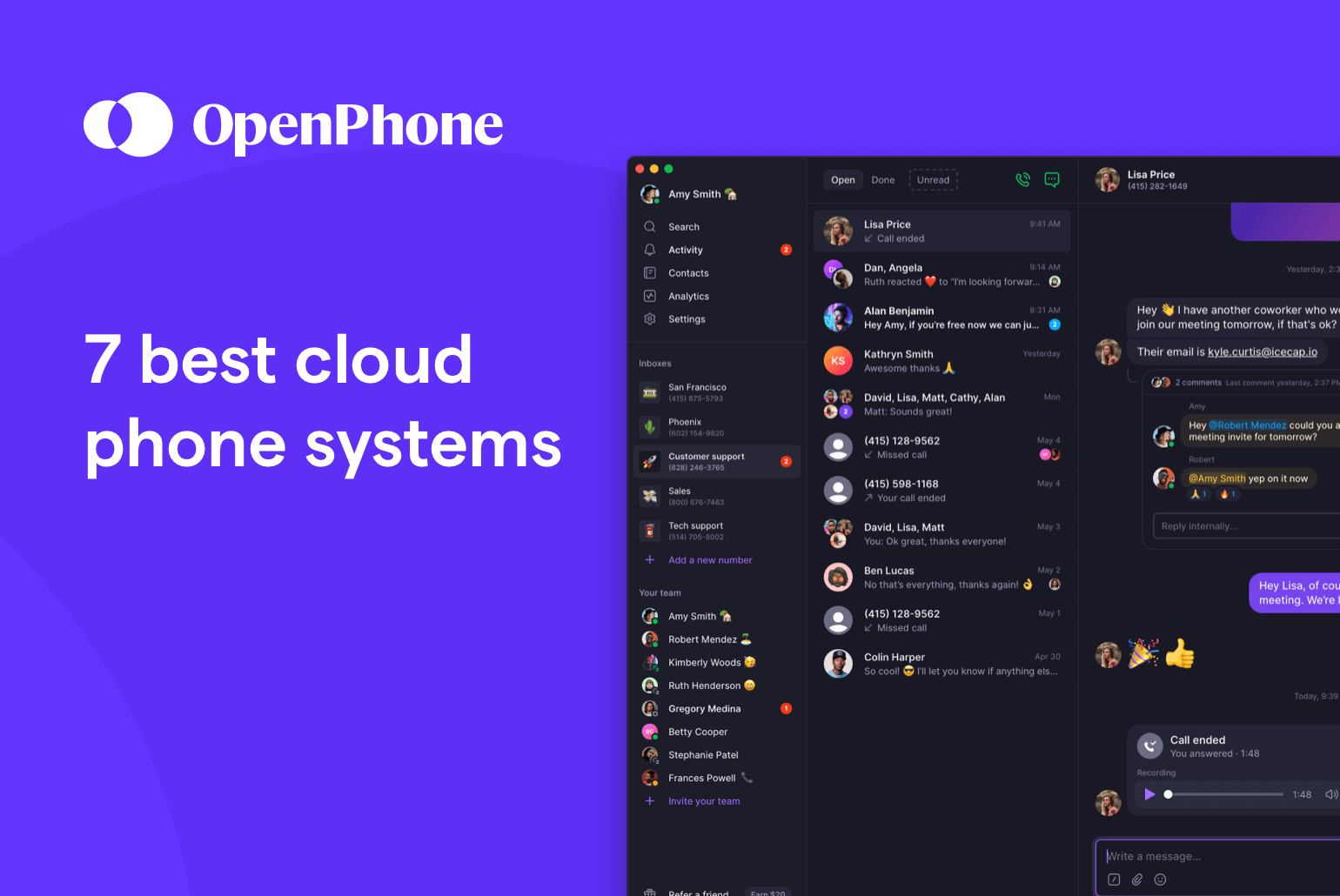There’s a reason analysts expect the VoIP market to grow to around $25 billion by 2025.
The communication needs of modern businesses have evolved significantly over the past few years. Cloud-based phone systems offer multiple benefits for remote and in-office teams — such as scalability and value for money.
Choosing the best cloud phone system can feel a little overwhelming, given the number of options. Whether you’re switching from old-school PSTN telephones or already using VoIP software, we’ll help you find the right business phone system for your business needs.
How we ranked the best cloud phone systems
We researched the best cloud phone systems on the market and found seven solutions to be the best. Here’s how we ranked them:
- Reliability: Downtime can cost you business and damage your reputation. You want a cloud-based system with excellent uptime history to ensure you can deliver a reliable experience to callers.
- User-friendliness: Complicated systems are a recipe for low buy-in with your team. You’ll face friction while implementing it and will need to spend extra time training employees. Why not keep your spending lean by selecting an easy-to-use cloud-based phone system?
- Third-party integrations: Integrations facilitate seamless exchange of data between apps. Selecting a cloud-based phone system that integrates with all the popular apps you already use eliminates the need to recreate data or complete repetitive, manual processes, saving time and resources.
- Customer support: If you run into an issue with the system, you can’t make callers wait for hours. You need support to offer quick assistance whenever you need it.
- Cost: While you shouldn’t just select the least-expensive cloud-based phone system, you’re still a business with a budget. You should look for services that don’t force you to overspend while still fulfilling your business communication needs.
- Value for money: A cost-effective business phone system is a no brainer. Look for a service with the right feature set to maximize the return on each invested dollar.
7 Best cloud phone systems
We picked seven cloud phone systems based on the key factors mentioned above. Each service has strengths and weaknesses that we’ll detail below.
1. OpenPhone
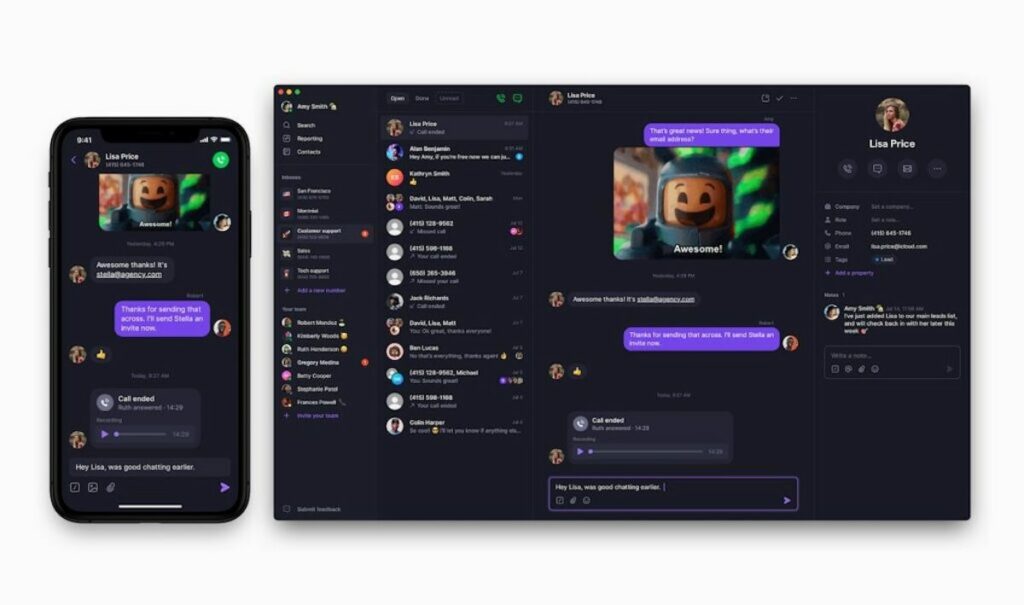
OpenPhone is the modern cloud-based phone system that can easily scale as your business grows. 🚀
Why does OpenPhone top the list?
You can start using OpenPhone within minutes by selecting a new local number (and a toll-free number) or porting your old number over to OpenPhone.
Once you have a phone number, you can share the number with your team to collaborate on client communications. You can also set up automated text messages and auto-attendants that free up your team’s time for more productive tasks. With OpenPhone, you can even schedule text messages to go out based on your contact’s timezone.
Need to text or call someone from your computer, smartphone, or tablet? OpenPhone is available on almost all popular operating systems, so you’re always connected with your team and clients.
Here are more features you get with OpenPhone:
- Free calling and texting to the US and Canada
- Browser, web, and mobile (iOS and Android) apps
- Custom contact properties, contact notes, and internal threads
- Integrations with popular platforms like Slack, Zapier, HubSpot, and Salesforce
- Call recording
- Voicemail transcriptions
- Affordable international rates
Unlike other cloud-based phone systems, OpenPhone’s pricing is clear and transparent. You pay per user per month depending on your plan (starting at $15 per user per month). Each user comes with one phone number; each number is just $5 per month if you need any additional numbers.
Price: Starts at $15 per user per month
2. Dialpad
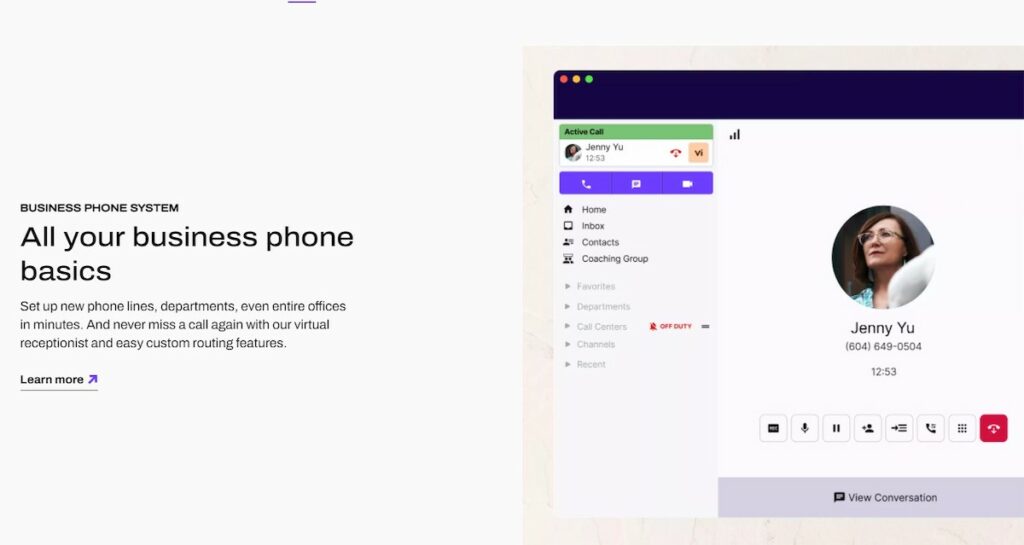
Dialpad is an AI-powered cloud-based phone system that offers standard features like unlimited calling in the US and Canada and unlimited text messaging (for US & Canadian customers only). You also get voicemail greetings and G Suite and Office 365 integrations on Dialpad’s standard plan, which costs $15 per user per month.
Unfortunately, Dialpad locks away the more useful integrations like Zapier and Slack in its Pro plan. Need to text internationally or have teammates be able to use more than one business phone number in your account? That requires an upgrade too.
You also can only have one office location with Dialpad’s Standard plan. If you have more locations, you need to upgrade. You also need at least three users to access the more expensive, higher-tier Pro plan.
Essentially, you pay a lot more for features you can get for a much lower price with other service providers.
Price: Starts at $15 per user per month
3. RingCentral
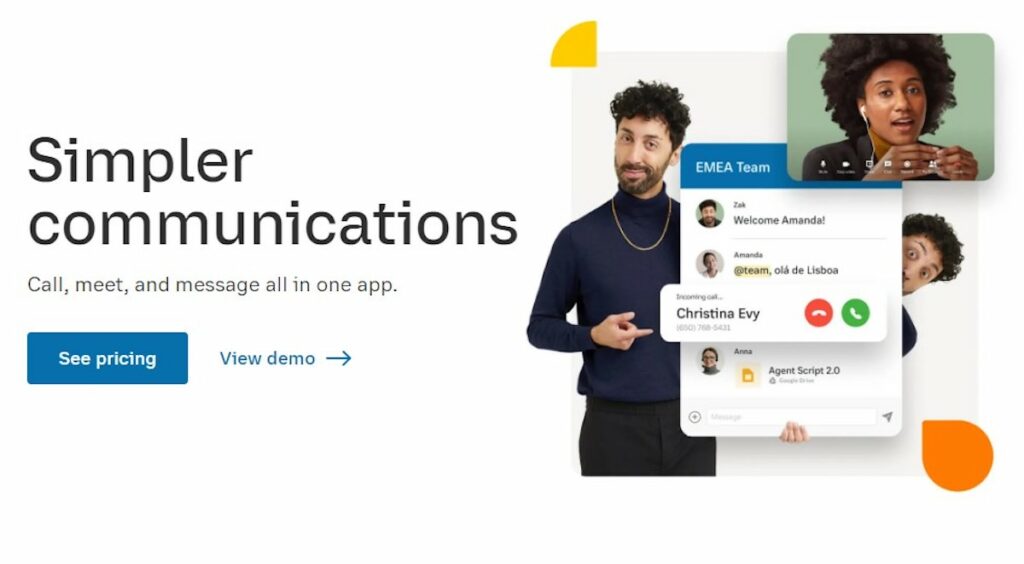
RingCentral is a cloud phone system for enterprise users. This legacy provider offers features like call forwarding, video conferencing, CRM integrations, and more.
The problem? They’re all available on higher-tier plans.
The basic plan is fairly bare-bones and offers only basic functions like voicemail-to-text, team messaging, and document sharing. If you want video conferencing or device status reports, you need to pay extra.
Another problem with RingCentral is the price. Even the basic plan — which lacks most features that make RingCentral popular — costs $14.99 per user per month.
Price: Starts at $14.99 per user per month
4. Google Voice
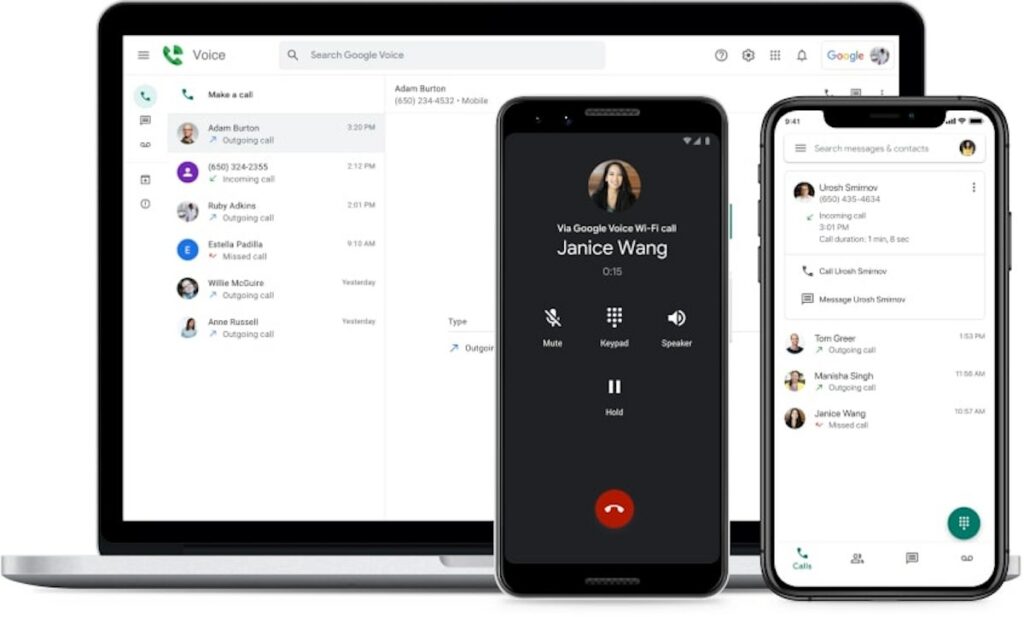
Though a free personal plan for Google Voice exists, you won’t get many features out of it beyond calling, texting, and voicemail. Google Voice for Google Workspace offers some standard features you’d want in a business cloud phone system across three paid plans, including unlimited calling and voicemail transcriptions. But you have to pay for a higher-tier (read: more expensive) plan to have an unlimited number of users or ring groups.
Plus, none of the plans offer options like toll-free numbers or call recordings. However, you can still use Google Voice as a starting point if you’re trying to keep your costs low while setting up your business.
Note that you also need a Google Workspace subscription for $6 a month, which can considerably increase your cost if you’re a solopreneur.
Price: Starts at $10 per user per month (plus $6 per month for Google Workspace)
5. Ooma
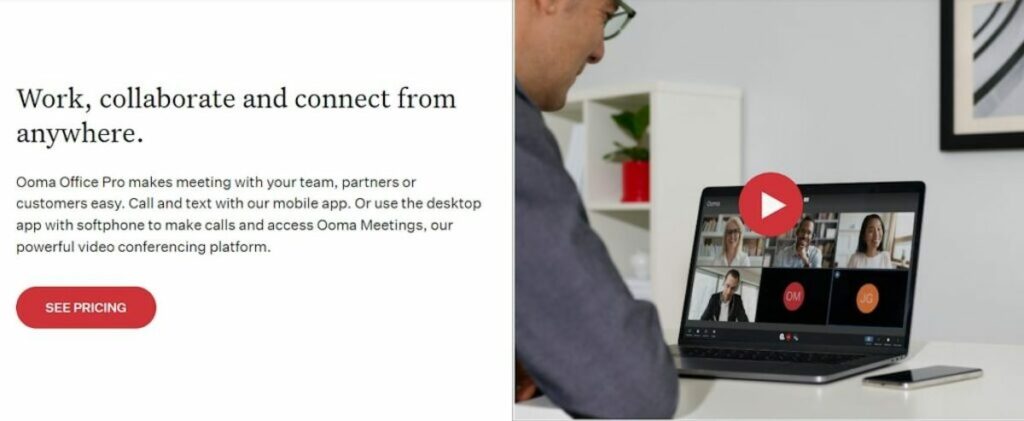
Ooma is a legacy phone system built for small businesses. With Ooma, you get all the basic features like unlimited calling and texting, but you might find the interface outdated.
Ooma offers virtual faxing via the mobile app and when opting for higher-tier plans, also provides integrations for Zendesk, Microsoft Office 365, and Salesforce, among others. You can also use Ooma the old-school way with analog phones or Ooma’s proprietary IP phones.
The legacy phone system checks many of the right boxes, except that Ooma only offers many essential features on its higher-tier plans. For instance, you need to upgrade to access features like voicemail transcriptions, call recording, and a desktop app. 😒
Price: Starts at $19.95 per user per month
6. Nextiva
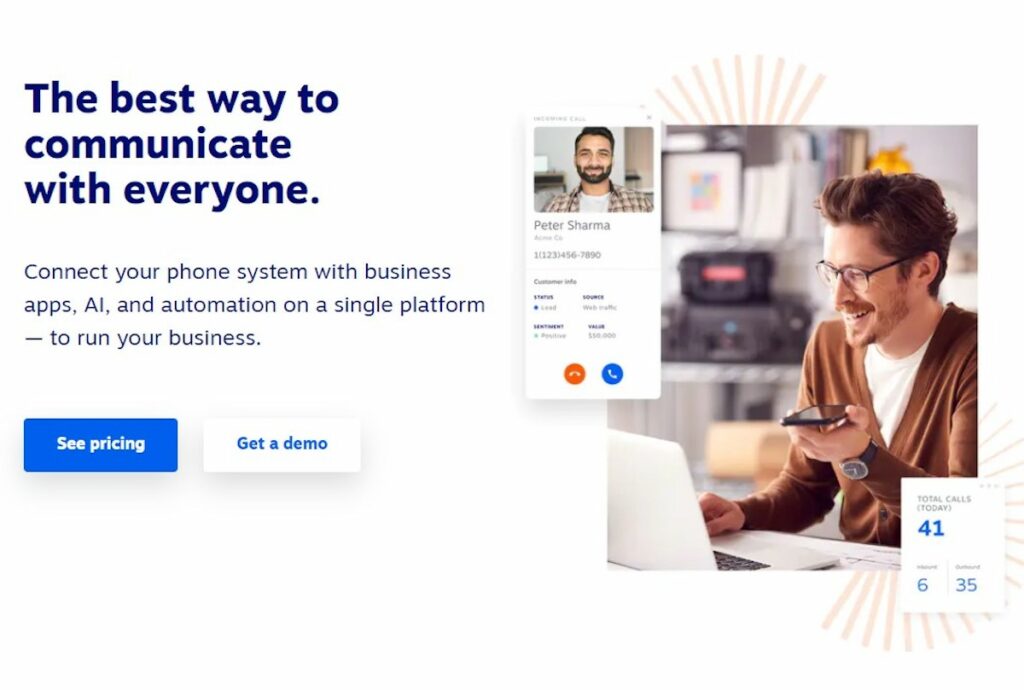
Nextiva bills itself as “the small business VoIP phone system”. The service provider has been around for over 15 years and has built a customer base of 100,000+ companies.
Though the cloud solution positions itself as ideal for small businesses, it’s evolved into a more suitable service for enterprise users.
Nextiva’s pricing confirms that it’s now focused on bigger teams. The basic plan costs $23.95 per user per month if you’re a team of four or fewer members. On their basic plan, you can’t text from their mobile app. 😲
On the other hand, if you’re a team of more than 20 and less than 100, you only pay $18.95 per user per month for the basic plan.
Price: Starts at $23.95 per user per month
7. Aircall
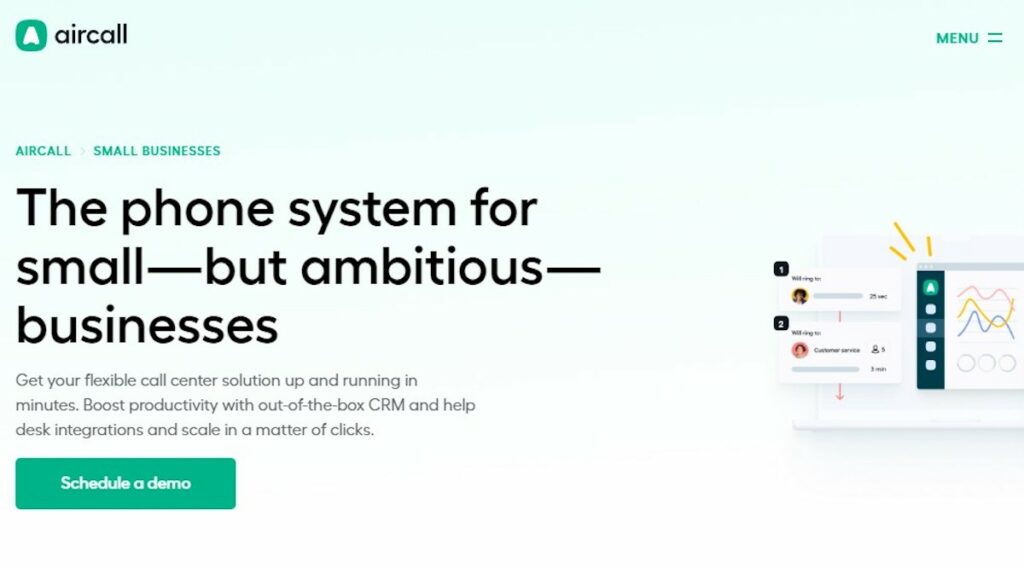
Aircall is a VoIP software built for call centers. Essentially, it combines the benefits of a traditional private branch exchange (PBX) system and modern VoIP phone systems by connecting your team members over a single network and allowing the team to access it from anywhere — except that it doesn’t offer all features you’d want in a cloud-based phone service.
For instance, the basic plan only offers standard features like calls and texts, click to call, and call recording.
There’s also a cap of 4,000 outbound text messages per user per month, which is fairly restrictive. Aircall doesn’t support MMS, voicemail transcription, or auto-replies either — all features you can get from many Aircall competitors.
Price: Starts at $30 per user per month
What is a cloud phone system?
A cloud-based phone system (also known as a cloud PBX system or hosted PBX) is a VoIP-based communication solution. A third-party provider like OpenPhone hosts the system. That way, you don’t need to have any physical assets on the premises.
No clunky desk phones required. ☎️
Cloud phone systems are a type of unified communications as a service (UCaaS). The UCaaS model isn’t just about having your phone on the cloud. It’s also about making team collaboration easy across all modes of business communication, including conferencing and group messaging.
How does a cloud-based phone system work?
When you dial a number, cloud phone systems rely on a VoIP service provider to connect you with the caller.
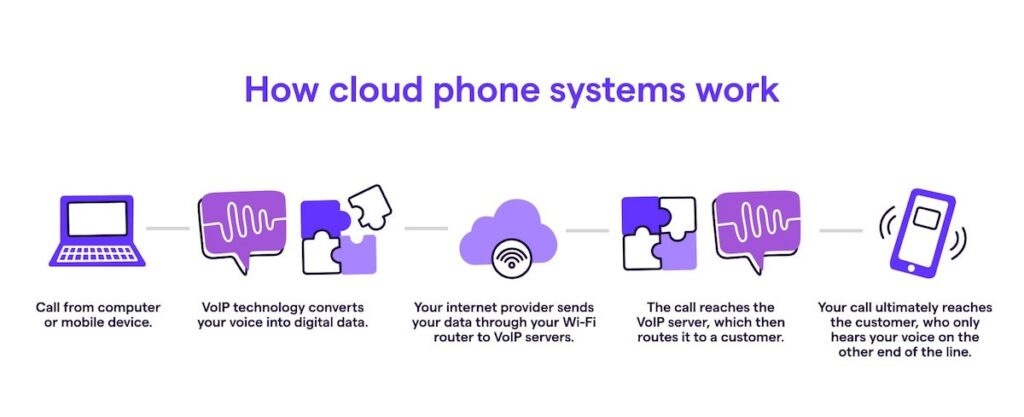
The cloud VoIP service provider routes the call by converting your voice into data packets and transmitting them using your internet protocol — that’s also why it’s called Voice over Internet Protocol (VoIP).
You can use a desk phone with a VoIP adapter, but a softphone makes the cloud system a lot more scalable because it doesn’t require Ethernet cables. A softphone is an app on your computer or smartphone that allows making calls using your internet connection.
To select the most scalable phone option for your company, you’ll also want to review what cloud-based phone systems offer as features. Softphones like OpenPhone also provide advanced features such as team analytics, auto-replies, and snippets.
There are more essential features to look for when selecting a cloud phone system, as we discuss below.
13 essential cloud phone system features
Modern teams need more than just the bare minimum. Here are cloud-based phone system features you should look for:
1. Shared numbers
Have you ever wished a team member could answer an important call when you’ve got your hands full with other things? It’s possible with a cloud phone system that offers shared numbers.
When someone calls your shared phone number, the device of everyone who shares it rings too. When one member answers the call, everyone’s devices stop ringing. Cool, right? 😎
Why you need shared numbers: You can shorten response times and provide callers with a better experience. Everyone with access to a number can also view call history, messages, and access voicemail, which means you’ll spend less time catching team members up on client interactions.
2. Interactive voice response (IVR)
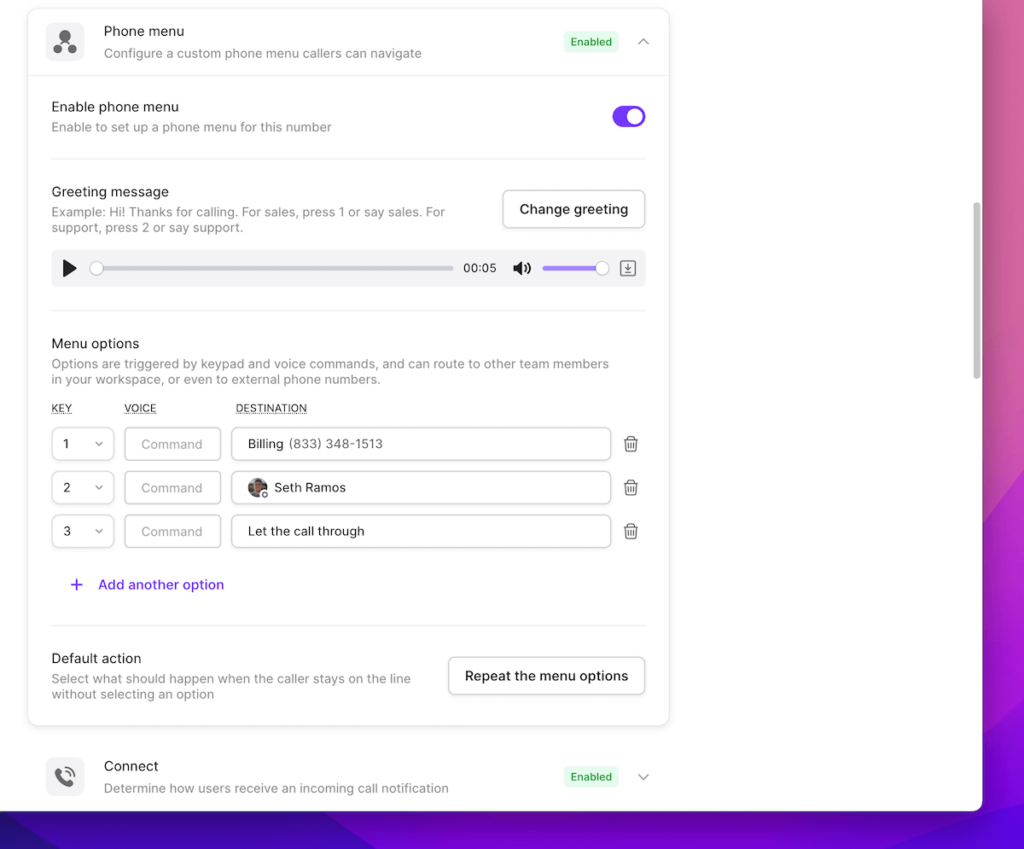
IVR helps your callers reach the right team without your help. IVR creates an easily navigable phone menu where users can select from a few options, and the IVR directs their call to the appropriate team based on those responses.
You’ve probably used IVR yourself. Ever called a business and heard “Press 1 for…”? That’s IVR.
Why you need IVR: IVR frees up a lot of time for teams otherwise spent directing callers to the right department. You can also set business hours or customize call routing by routing phone calls simultaneously to all members or select members based on your team’s needs.
3. Call recording
Call recording is exactly what it sounds like. You can record phone calls on your computer or smartphone and use it later to recall what you discussed with the client during the previous call. If you want to make reviewing calls easier, you can use tools like Otter.ai that convert your recordings into call transcriptions.
Why you need call recording: Call recording can provide team members with information about previous client interactions and give your business a clear communication trail in case a disagreement arises. You can also continually improve your team’s communication externally by coaching teammates based on call recordings.
4. Voicemail transcriptions
The voicemail transcription feature converts voicemail messages into text. Your cloud-based phone system transcribes the audio and sends it to you via email or text message.
Why you need voicemail transcriptions: Listening to every voicemail message you receive can be time-consuming. Voicemail transcription allows you to skim through voicemail messages and get important details. You can simply search the voicemail transcription for keywords when you want to revisit a specific part of the conversation instead of playing back a recording.
5. Integrations
Integrations allow seamless data exchange between the cloud system and other apps you use for business.
For instance, if you add a new customer’s contact to your cloud CRM, you might also want the contact on your cloud phone system. Integrating the cloud phone system with the CRM automates this process by automatically syncing new contacts.
Why you need integrations: Integrations eliminate the need to do data entry and other mundane tasks so you can spend time on more important responsibilities.
6. MMS support
MMS (Multimedia Messaging Service) and SMS (Short Message Service) are both texting services, but MMS is a way of sharing multimedia content. With MMS, you can send interactive content like GIFs and more characters per message than SMS. Some cloud-based phone systems like Aircall lack MMS support, which limits your communication choices. 😒
Why you need MMS support: When you send an SMS longer than 160 characters, it’ll split into two or more texts. It’s also possible that those two texts will arrive out of order and confuse the recipient. Using MMS addresses this problem. Modern VoIP systems like OpenPhone support up to 1,600 characters and file types including GIFs, videos, and audio files, so you can delight your customers or gather more context from your contacts.
7. Scalable virtual number options
The best cloud systems let you get as many phone numbers as your team requires. Unlike traditional deskphones, you can then access multiple virtual numbers from any device with an internet connection.
Why you need scalable number options: As you expand to new markets or your team grows, you can easily add more numbers to your account. Virtual numbers also don’t require you to use one specific device (like you would with a traditional phone system) since you can access it from any device. You can also get local numbers in regions outside of your current location, which isn’t an option with traditional phone systems.
8. Real-time and async collaboration
A cloud system should offer real-time and async collaboration with features like shared numbers and direct messaging. Collaboration helps your teams not only keep in touch with one another, it also helps you provide quick solutions to callers.
Why you need real-time and async collaboration: Collaboration tools enable you to provide a better experience to anyone who reaches out to your business. For instance, you can make warm call transfers by relaying important information to a teammate, offering a better experience to the caller.
9. Snippets
Snippets are essentially message templates containing any sort of repeat text messages you find your team sending routinely.
Why you need snippets: Cloud-based phone systems streamline your business communication. Snippets are one of several ways that cloud communications help you save time. You can quickly use snippet texts to answer commonly asked questions or follow up with your contacts.
10. Auto-replies
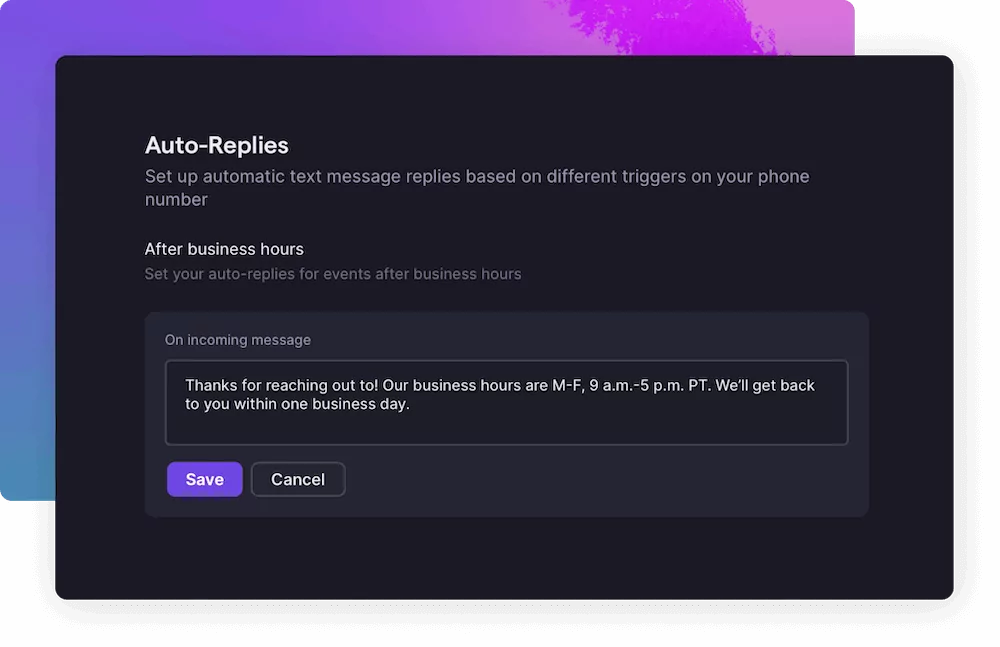
Waiting more than 20 minutes to respond to a text can be seen as rude. So should you always have your device handy? Well, not if your cloud-based phone system offers auto-replies.
Auto-replies can respond to text messages based on predefined triggers, even when you’re sleeping.😴 So your clients and prospects will always receive a response right away when they text.
Why you need auto-replies: When you’re unavailable, auto-replies acknowledge receipt of SMS and can help you set expectations on when they can expect to hear back from you. You can also use auto-replies to automatically text someone when your team misses a call.
11. Contact notes
When your teammates can read through previous client interactions, it provides them the context they need to personalize the conversation when answering client calls. If your cloud-based phone system has access to contact notes, you’ll have the information about previous communication with the client so you can get directly to the point.
Why you need contact notes: Calling a client and having them repeat details they’ve already given results in a poor experience. Contact notes make collaborating effortless because team members will have them handy without additional manual work.
12. Auto-logging
Auto-logging pulls customer messages and calls into your CRM — no manual data migration necessary. Your colleagues on the sales team will always have complete visibility of customer service calls made on all client accounts.
The best cloud phone systems like OpenPhone integrate with the most popular CRMs like HubSpot. If you use an up-and-coming CRM platform, you can add webhooks for auto-logging.
Why you need auto-logging: Auto-logging gives your team the proper context to continue conversations with any business contacts. For managers, logging can also give you a clearer picture of your department’s productivity. The best part? There’s no manual effort required.
13. Adjusting your availability
The ideal cloud-based phone system lets you adjust your team’s availability. Everyone on your team and in other departments should have complete clarity over which team member is working at a given time to ensure they transfer client calls to the right person — and that person is available.
Why you need the option to adjust availability: Imagine telling a caller you need to transfer them to your teammate and they don’t answer. 😳 That can reflect poorly on your business. Phone system providers like OpenPhone let you set availability at the phone number level with business hours and user level by setting a work schedule, ensuring that every member is on the same page about a teammate’s availability.
How much should I expect to pay for a cloud-based phone system?
Cloud-based phone systems cost anywhere between $10 and $50 per user per month based on the plan you choose and the system’s features. If you’re looking for a scalable cloud phone system that doesn’t cost a fortune, try OpenPhone.
How can cloud-based phone systems help productivity?
Cloud-based phone systems enable more effective communication between teams and clients. When employees aren’t near their work laptops, they can use a mobile device to stay connected and respond to calls. Add features like auto-replies and auto-logging to the mix, and you’ve got a feature set that significantly improves productivity by streamlining processes or automating them.
Join OpenPhone, the best-in-class cloud phone system
Say goodbye to outdated landlines and use modern technology to deliver top-notch client experiences as you build relationships via calling and texting. Why use old-generation communication methods when you can get better call quality and access on almost any device — computer, iOS, Android, and web — for a lower cost?
OpenPhone is a top cloud phone system for growing teams. If you’re looking for a cloud-based phone system that supports remote collaboration on communication and your continued growth, why not give OpenPhone a try? Sign up for a free trial of OpenPhone today.
